Reconciling the Discrepancy of Post-Volcanic Cooling Estimated from Tree-Ring Reconstructions and Model Simulations over the Tibetan Plateau
Abstract
1. Introduction
2. Data and Methods
2.1. Tree-Ring-Based Temperature Reconstructions
2.2. Information of Volcanic Eruption and El Niño Events
2.3. Climate Model Simulations
3. Results and Discussion
3.1. Simulated Magnitudes of Post-Volcanic Cooling on the TP and Its Comparison with the Reconstructions
3.2. Influence of El Niño Events on the Simulated Magnitudes of Post-Volcanic Cooling on the TP
4. Conclusions
Supplementary Materials
Author Contributions
Funding
Acknowledgments
Conflicts of Interest
References
- Robock, A. Volcanic eruptions and climate. Rev. Geophys. 2000, 38, 191–219. [Google Scholar] [CrossRef]
- Hansen, J.; Sato, M.; Ruedy, R.; Kharecha, P.; Lacis, A.; Miller, R.; Nazarenko, L.; Lo, K.; Schmidt, G.A.; Russell, G.; et al. Climate simulations for 1880-2003 with GISS modelE. Clim. Dyn. 2007, 29, 661–696. [Google Scholar] [CrossRef]
- Luterbacher, J.; Pfister, C. The year without a summer. Nat. Geosci. 2015, 8, 246–248. [Google Scholar] [CrossRef]
- Sigl, M.; Winstrup, M.; McConnell, J.R.; Welten, K.C.; Plunkett, G.; Ludlow, F.; Buntgen, U.; Caffee, M.; Chellman, N.; Dahl-Jensen, D.; et al. Timing and climate forcing of volcanic eruptions for the past 2,500 years. Nature 2015, 523, 543–549. [Google Scholar] [CrossRef] [PubMed]
- Büntgen, U.; Myglan, V.S.; Ljungqvist, F.C.; McCormick, M.; Di Cosmo, N.; Sigl, M.; Jungclaus, J.; Wagner, S.; Krusic, P.J.; Esper, J.; et al. Cooling and societal change during the Late Antique Little Ice Age from 536 to around 660 AD. Nat. Geosci. 2016, 9, 231–236. [Google Scholar] [CrossRef]
- Mann, M.E.; Fuentes, J.D.; Rutherford, S. Underestimation of volcanic cooling in tree-ring-based reconstructions of hemispheric temperatures. Nat. Geosci. 2012, 5, 202–205. [Google Scholar] [CrossRef]
- Anchukaitis, K.J.; Breitenmoser, P.; Briffa, K.R.; Buchwal, A.; Buntgen, U.; Cook, E.R.; D’Arrigo, R.D.; Esper, J.; Evans, M.N.; Frank, D.; et al. Tree rings and volcanic cooling. Nat. Geosci. 2012, 5, 836–837. [Google Scholar] [CrossRef]
- Stoffel, M.; Khodri, M.; Corona, C.; Guillet, S.; Poulain, V.; Bekki, S.; Guiot, J.; Luckman, B.H.; Oppenheimer, C.; Lebas, N.; et al. Estimates of volcanic-induced cooling in the Northern Hemisphere over the past 1,500 years. Nat. Geosci. 2015, 8, 784–788. [Google Scholar] [CrossRef]
- Hartl-Meier, C.T.M.; Buntgen, U.; Smerdon, J.E.; Zorita, E.; Krusic, P.J.; Ljungqvist, F.C.; Schneider, L.; Esper, J. Temperature Covariance in Tree Ring Reconstructions and Model Simulations Over the Past Millennium. Geophys. Res. Lett. 2017, 44, 9458–9469. [Google Scholar] [CrossRef]
- Kumar, K.K.; Rajagopalan, B.; Cane, M.A. On the weakening relationship between the Indian monsoon and ENSO. Science 1999, 284, 2156–2159. [Google Scholar] [CrossRef]
- Li, J.B.; Xie, S.P.; Cook, E.R.; Huang, G.; D’Arrigo, R.; Liu, F.; Ma, J.; Zheng, X.T. Interdecadal modulation of El Nino amplitude during the past millennium. Nat. Clim. Chang. 2011, 1, 114–118. [Google Scholar] [CrossRef]
- Shaman, J.; Tziperman, E. The effect of ENSO on Tibetan plateau snow depth: A stationary wave teleconnection mechanism and implications for the south Asian monsoons. J. Clim. 2005, 18, 2067–2079. [Google Scholar] [CrossRef]
- Miyakoda, K.; Kinter, J.L.; Yang, S. The role of ENSO in the south Asian monsoon and pre-monsoon signals over the Tibetan plateau. J. Meteorol. Soc. Jpn. 2003, 81, 1015–1039. [Google Scholar] [CrossRef]
- Xu, H.; Hong, Y.T.; Hong, B.; Zhu, Y.X.; Wang, Y. Influence of ENSO on multi-annual temperature variations at Hongyuan, NE Qinghai-Tibet plateau: Evidence from delta(13) C of spruce tree rings. Int. J. Climatol. 2010, 30, 120–126. [Google Scholar] [CrossRef]
- Yang, M.X.; Yao, T.D.; He, Y.Q.; Thompson, L.G. ENSO events recorded in the Guliya ice core. Clim. Chang. 2000, 47, 401–409. [Google Scholar] [CrossRef]
- Gao, J.; He, Y.; Masson-Delmotte, V.; Yao, T.D. ENSO Effects on Annual Variations of Summer Precipitation Stable Isotopes in Lhasa, Southern Tibetan Plateau. J. Clim. 2018, 31, 1173–1182. [Google Scholar] [CrossRef]
- Duan, J.P.; Li, L.; Ma, Z.G.; Esper, J.; Buntgen, U.; Xoplaki, E.; Zhang, D.J.; Wang, L.; Yin, H.; Luterbacher, J. Summer Cooling Driven by Large Volcanic Eruptions over the Tibetan Plateau. J. Clim. 2018, 31, 9869–9879. [Google Scholar] [CrossRef]
- Liu, X.D.; Chen, B.D. Climatic warming in the Tibetan Plateau during recent decades. Int. J. Climatol. 2000, 20, 1729–1742. [Google Scholar] [CrossRef]
- You, Q.L.; Kang, S.C.; Pepin, N.; Yan, Y.P. Relationship between trends in temperature extremes and elevation in the eastern and central Tibetan Plateau, 1961–2005. Geophys. Res. Lett. 2008, 35. [Google Scholar] [CrossRef]
- Duan, J.P.; Ma, Z.G.; Li, L.; Zheng, Z.Y. August-September Temperature Variability on the Tibetan Plateau: Past, Present, and Future. J. Geophys. Res. Atmos. 2019, 124, 6057–6068. [Google Scholar] [CrossRef]
- Brönnimann, S.; Xoplaki, E.; Casty, C.; Pauling, A.; Luterbacher, J. ENSO influence on Europe during the last centuries. Clim. Dyn. 2007, 28, 181–197. [Google Scholar] [CrossRef]
- Wu, T.W.; Yu, R.C.; Zhang, F.; Wang, Z.Z.; Dong, M.; Wang, L.N.; Jin, X.; Chen, D.L.; Li, L. The Beijing Climate Center atmospheric general circulation model: Description and its performance for the present-day climate. Clim. Dyn. 2010, 34, 123–147. [Google Scholar] [CrossRef]
- Landrum, L.; Otto-Bliesner, B.L.; Wahl, E.R.; Conley, A.; Lawrence, P.J.; Rosenbloom, N.; Teng, H.Y. Last Millennium Climate and Its Variability in CCSM4. J. Clim. 2013, 26, 1085–1111. [Google Scholar] [CrossRef]
- Zhou, T.J.; Wu, B.; Wen, X.Y.; Li, L.J.; Wang, B. A fast version of LASG/IAP climate system model and its 1000-year control integration. Adv. Atmos. Sci. 2008, 25, 655–672. [Google Scholar] [CrossRef]
- Man, W.M.; Zhou, T.J. Regional-scale surface air temperature and East Asian summer monsoon changes during the last millennium simulated by the FGOALS-gl climate system model. Adv. Atmos. Sci. 2014, 31, 765–778. [Google Scholar] [CrossRef]
- Schmidt, G.A.; Kelley, M.; Nazarenko, L.; Ruedy, R.; Russell, G.L.; Aleinov, I.; Bauer, M.; Bauer, S.E.; Bhat, M.K.; Bleck, R.; et al. Configuration and assessment of the GISS ModelE2 contributions to the CMIP5 archive. J. Adv. Model. Earth Syst. 2014, 6, 141–184. [Google Scholar] [CrossRef]
- Dufresne, J.L.; Foujols, M.A.; Denvil, S.; Caubel, A.; Marti, O.; Aumont, O.; Balkanski, Y.; Bekki, S.; Bellenger, H.; Benshila, R.; et al. Climate change projections using the IPSL-CM5 Earth System Model: From CMIP3 to CMIP5. Clim. Dyn. 2013, 40, 2123–2165. [Google Scholar] [CrossRef]
- Watanabe, S.; Hajima, T.; Sudo, K.; Nagashima, T.; Takemura, T.; Okajima, H.; Nozawa, T.; Kawase, H.; Abe, M.; Yokohata, T.; et al. MIROC-ESM 2010: Model description and basic results of CMIP5-20c3m experiments. Geosci. Model Dev. 2011, 4, 845–872. [Google Scholar] [CrossRef]
- Jungclaus, J.H.; Lohmann, K.; Zanchettin, D. Enhanced 20th-century heat transfer to the Arctic simulated in the context of climate variations over the last millennium. Clim. Past 2014, 10, 2201–2213. [Google Scholar] [CrossRef]
- Yukimoto, S.; Adachi, Y.; Hosaka, M.; Sakami, T.; Yoshimura, H.; Hirabara, M.; Tanaka, T.Y.; Shindo, E.; Tsujino, H.; Deushi, M.; et al. A New Global Climate Model of the Meteorological Research Institute: MRI-CGCM3-Model Description and Basic Performance. J. Meteorol. Soc. Jpn. 2012, 90, 23–64. [Google Scholar] [CrossRef]
- Swingedouw, D.; Mignot, J.; Ortega, P.; Khodri, M.; Menegoz, M.; Cassou, C.; Hanquiez, V. Impact of explosive volcanic eruptions on the main climate variability modes. Glob. Planet. Chang. 2017, 150, 24–45. [Google Scholar] [CrossRef]
- Khodri, M.; Izumo, T.; Vialard, J.; Janicot, S.; Cassou, C.; Lengaigne, M.; Mignot, J.; Gastineau, G.; Guilyardi, E.; Lebas, N.; et al. Tropical explosive volcanic eruptions can trigger El Nino by cooling tropical Africa. Nat. Commun. 2017, 8, 778. [Google Scholar] [CrossRef] [PubMed]
- Zanchettin, D. Aerosol and Solar Irradiance Effects on Decadal Climate Variability and Predictability. Curr. Clim. Chang. Rep. 2017, 3, 150–162. [Google Scholar] [CrossRef]
- Pausata, F.S.R.; Karamperidou, C.; Caballero, R.; Battisti, D.S. ENSO response to high-latitude volcanic eruptions in the Northern Hemisphere: The role of the initial conditions. Geophys. Res. Lett. 2016, 43, 8694–8702. [Google Scholar] [CrossRef]
- Clement, A.C.; Seager, R.; Cane, M.A.; Zebiak, S.E. An ocean dynamical thermostat. J. Clim. 1996, 9, 2190–2196. [Google Scholar] [CrossRef]
- Timmreck, C. Modeling the climatic effects of large explosive volcanic eruptions. Wiley Interdiscip. Rev. Clim. Chang. 2012, 3, 545–564. [Google Scholar] [CrossRef]
- Timmreck, C.; Graf, H.F.; Lorenz, S.J.; Niemeier, U.; Zanchettin, D.; Matei, D.; Jungclaus, J.H.; Crowley, T.J. Aerosol size confines climate response to volcanic super-eruptions. Geophys. Res. Lett. 2010, 37. [Google Scholar] [CrossRef]
- Zanchettin, D.; Khodri, M.; Timmreck, C.; Toohey, M.; Schmidt, A.; Gerber, E.P.; Hegerl, G.; Robock, A.; Pausata, F.S.R.; Ball, W.T.; et al. The Model Intercomparison Project on the climatic response to Volcanic forcing (VolMIP): Experimental design and forcing input data for CMIP6. Geosci. Model Dev. 2016, 9, 2701–2719. [Google Scholar] [CrossRef]
- Wang, L.; Duan, J.P.; Chen, J.; Huang, L.; Shao, X.M. Temperature reconstruction from tree-ring maximum density of Balfour spruce in eastern Tibet, China. Int. J. Climatol. 2010, 30, 972–979. [Google Scholar] [CrossRef]
- Gergis, J.L.; Fowler, A.M. A history of ENSO events since AD 1525: Implications for future climate change. Clim. Chang. 2009, 92, 343–387. [Google Scholar] [CrossRef]
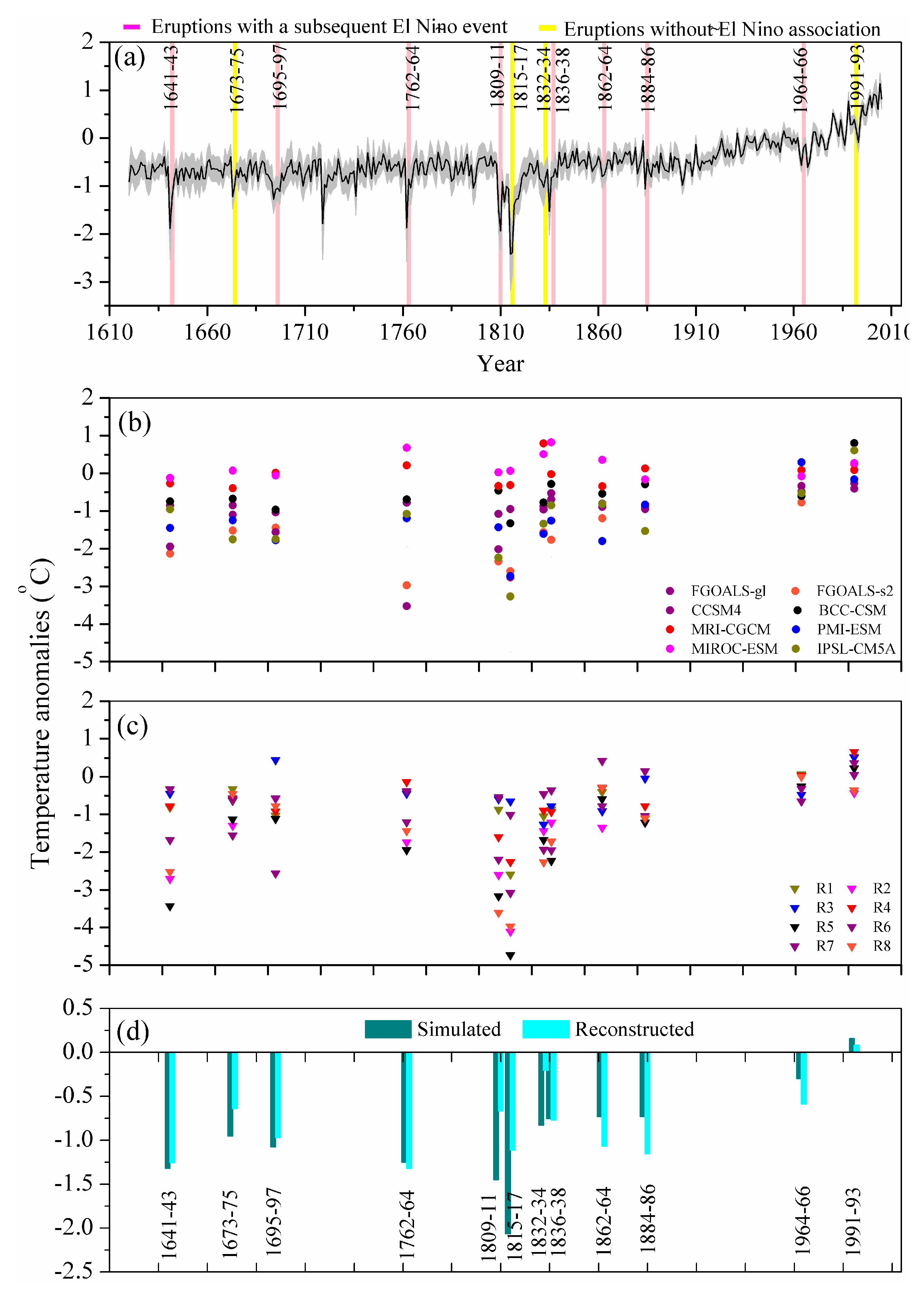
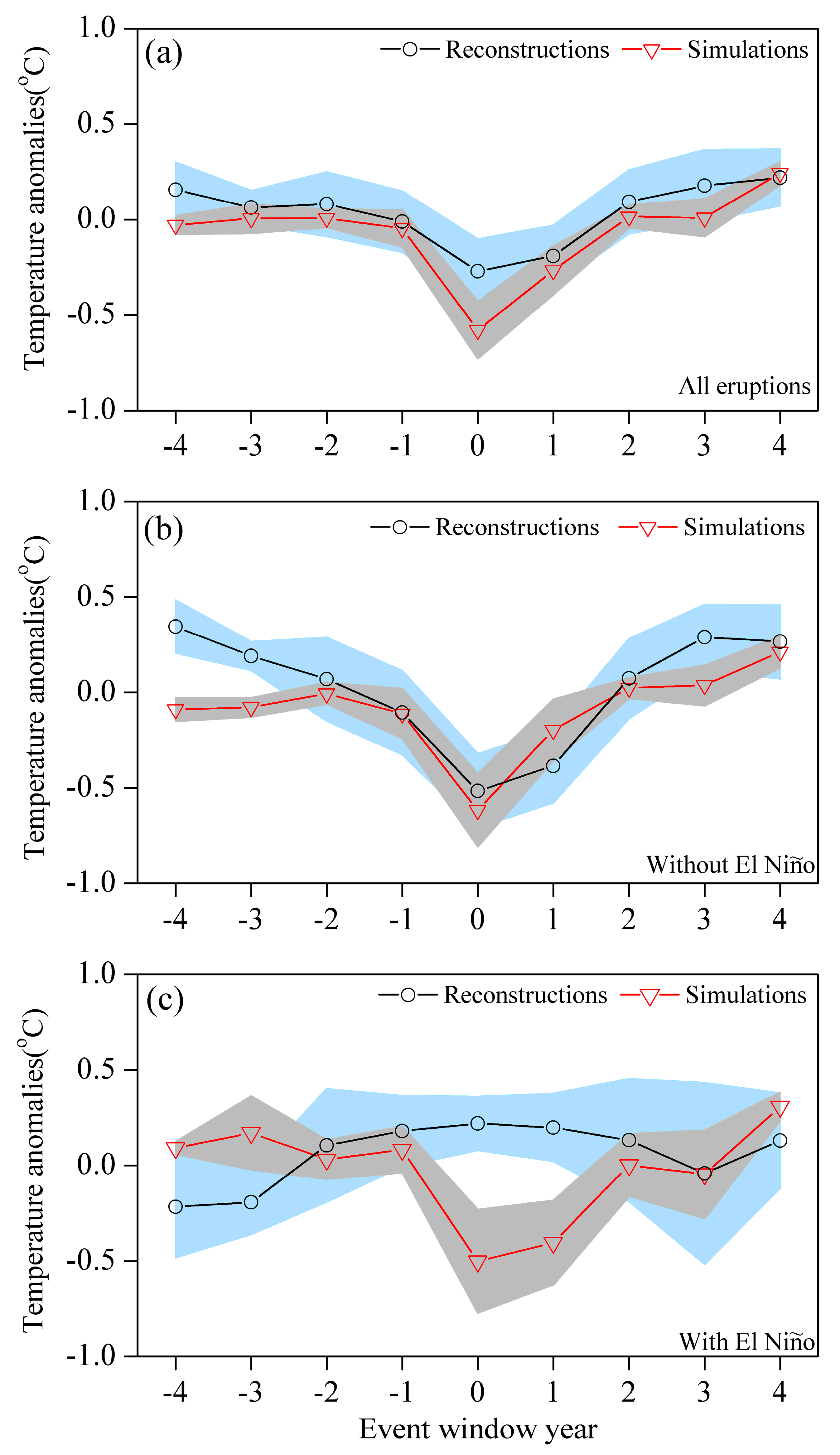
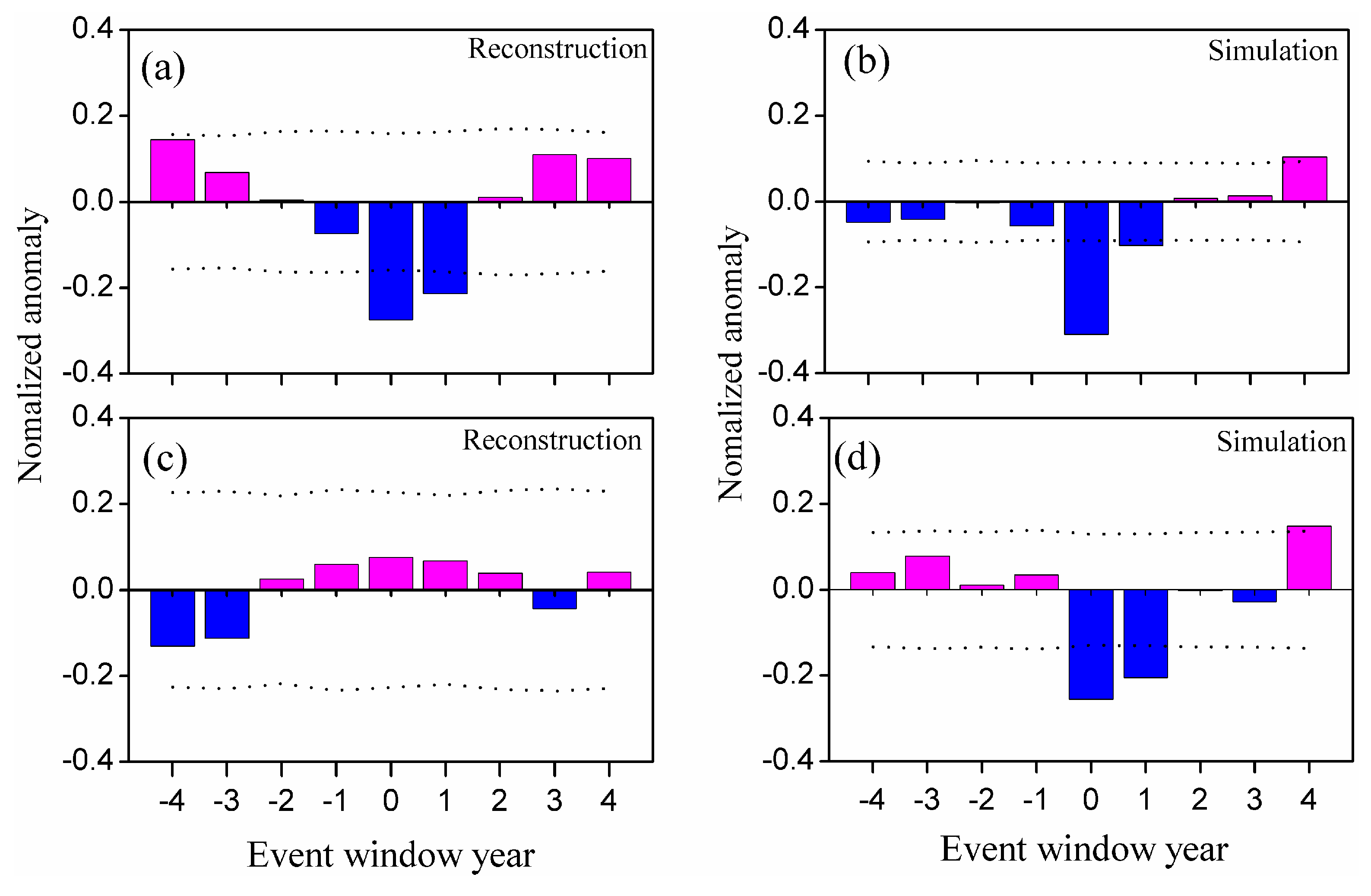
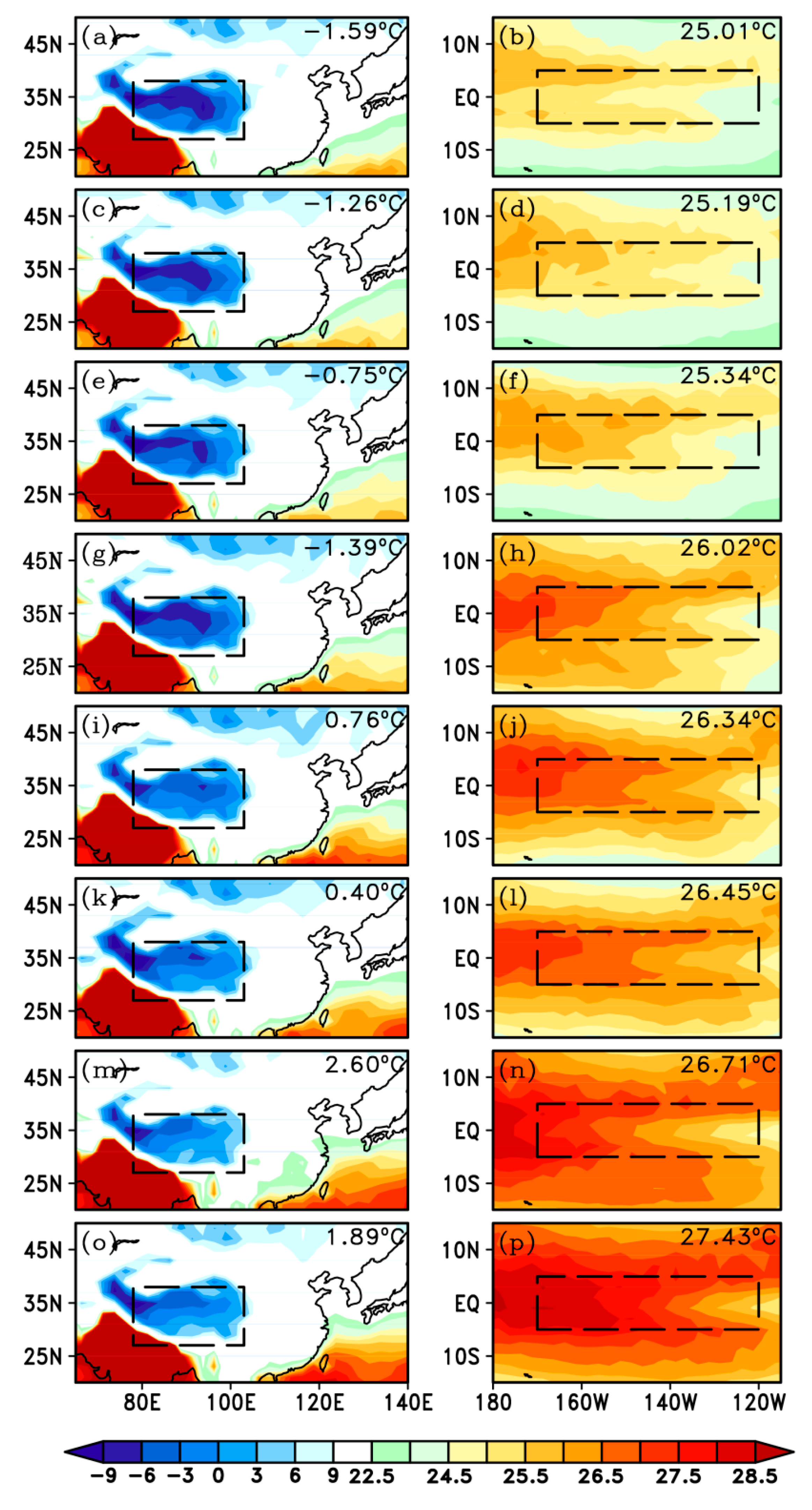
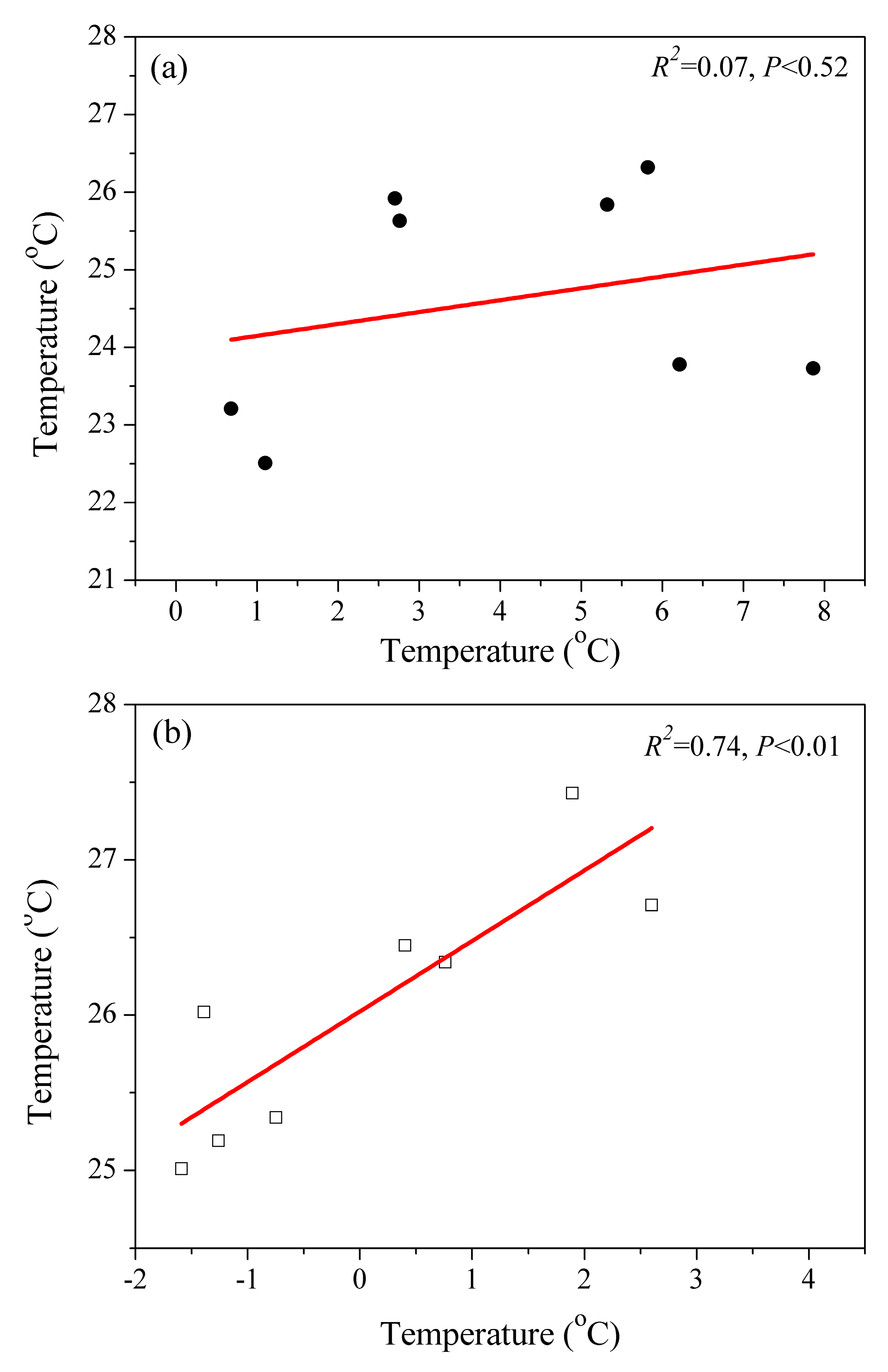
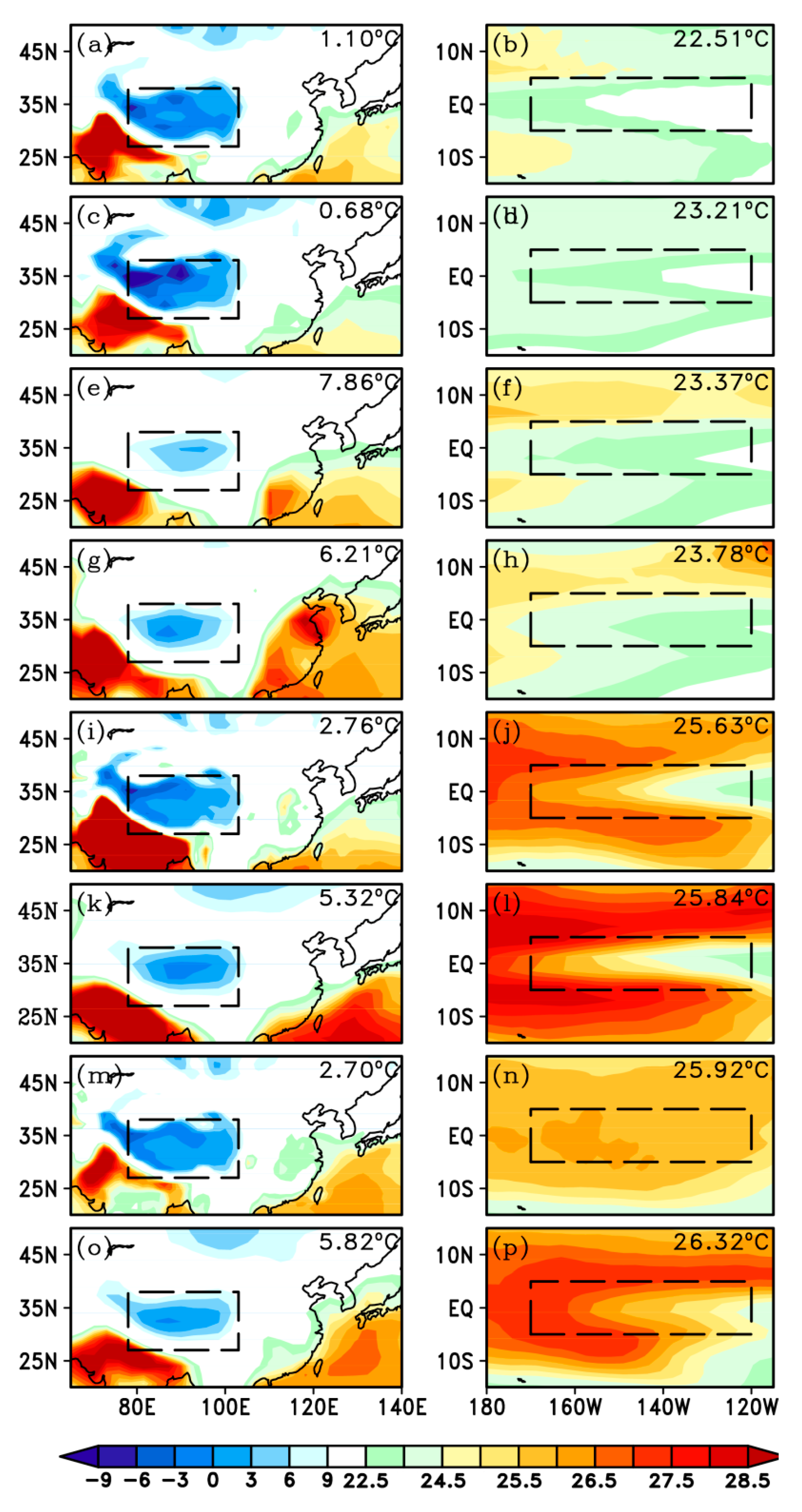
| Event Year | GVF (W m−2) | Simulated TAug–Sep | Reconstructed TAug–Sep |
|---|---|---|---|
| 1641 | −11.84 | −1.32 °C | −1.26 °C |
| 1673 | −3.11 | −0.95 °C | −0.64 °C |
| 1695 | −10.24 | −1.07 °C | −0.97 °C |
| 1762 | −3.52 | −1.25 °C | −1.32 °C |
| 1809 | −12.01 | −1.45 °C | −0.67 °C |
| 1815 | −17.20 | −2.07 °C | −1.11 °C |
| 1832 | −6.46 | −0.83 °C | −0.21 °C |
| 1836 | −6.57 | −0.75 °C | −0.77 °C |
| 1862 | −4.03 | −0.73 °C | −1.07 °C |
| 1884 | −5.84 | −0.74 °C | −1.15 °C |
| 1964 | −3.75 | −0.30 °C | −0.59 °C |
| 1991 | −6.49 | 0.16 °C | 0.08 °C |
| Model Name | Ensemble | Time Period | Main References |
|---|---|---|---|
| BCC-CSM1.1 | r1i1p1 | 850–2000 | [22] |
| CCSM4 | r1i1p1 | 850–2005 | [23] |
| FGOALS-gl | r1i1p1 | 1000–1999 | [24] |
| FGOALS-s2 | r1i1p1 | 850–2005 | [25] |
| GISS-E2-R | r1i1p121–128 | 850–2005 | [26] |
| IPSL-CM5A-LR | r1i1p1 | 850–2005 | [27] |
| MIROC-ESM | r1i1p1 | 850–2005 | [28] |
| MPI-ESM-P | r1i1p1 | 850–2005 | [29] |
| MRI-CGCM3 | r1i1p1 | 850–2005 | [30] |
© 2019 by the authors. Licensee MDPI, Basel, Switzerland. This article is an open access article distributed under the terms and conditions of the Creative Commons Attribution (CC BY) license (http://creativecommons.org/licenses/by/4.0/).
Share and Cite
Duan, J.; Wu, P.; Ma, Z. Reconciling the Discrepancy of Post-Volcanic Cooling Estimated from Tree-Ring Reconstructions and Model Simulations over the Tibetan Plateau. Atmosphere 2019, 10, 738. https://doi.org/10.3390/atmos10120738
Duan J, Wu P, Ma Z. Reconciling the Discrepancy of Post-Volcanic Cooling Estimated from Tree-Ring Reconstructions and Model Simulations over the Tibetan Plateau. Atmosphere. 2019; 10(12):738. https://doi.org/10.3390/atmos10120738
Chicago/Turabian StyleDuan, Jianping, Peili Wu, and Zhuguo Ma. 2019. "Reconciling the Discrepancy of Post-Volcanic Cooling Estimated from Tree-Ring Reconstructions and Model Simulations over the Tibetan Plateau" Atmosphere 10, no. 12: 738. https://doi.org/10.3390/atmos10120738
APA StyleDuan, J., Wu, P., & Ma, Z. (2019). Reconciling the Discrepancy of Post-Volcanic Cooling Estimated from Tree-Ring Reconstructions and Model Simulations over the Tibetan Plateau. Atmosphere, 10(12), 738. https://doi.org/10.3390/atmos10120738





